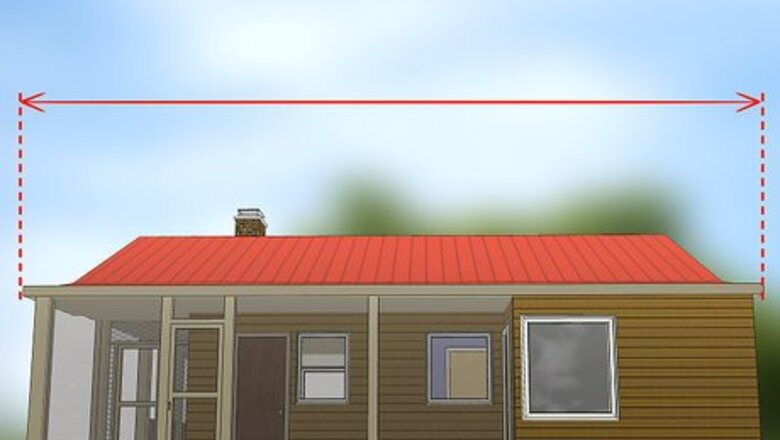
views
Measuring the Roof and Purchasing Materials
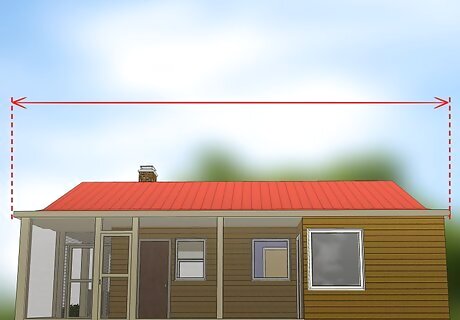
Measure the length of the roof that you're working on. Rain gutters should be attached to the fascia and run the entire length of the roof, ending with a downspout. Use a measuring tape to determine the length of the gutter. If the gutter run measures longer than 40 feet (12.2 m), it should be positioned to pitch down from the middle, aimed toward a downspout at each end. If the gutter is shorter than this length, it will slope down to the left or right toward a single gutter. Whether you obtain your measurements from a ladder or the top of the roof, exercise caution: do not lean without support, place a ladder on uneven ground, or wear shoes without adequate traction.
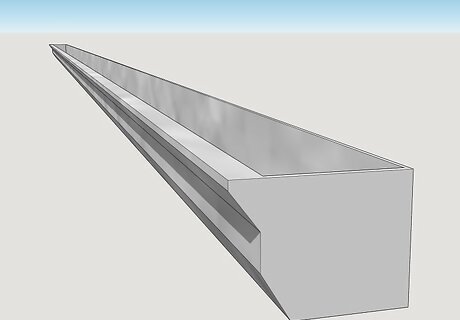
Purchase at least the total length of gutter along with additional materials. Head to a home improvement store for gutter material, fascia brackets, and downspout(s). A fascia bracket must be attached to every other rafter tail, which is approximately every 32 inches (81.3 cm). For example, if the roof length is 35 feet (10.7 m), dividing by 32 inches (81.3 cm) nets 13.12, meaning you need to purchase 13 fascia brackets and at least 35 feet (10.7 m) of gutter. Buy 1 downspout for gutters less than 40 feet (12.2 m) and 2 for anything longer. Avoid regions with hose bibs, sidewalks, and electric meters. Gutters come anywhere between 4–6 in (10–15 cm) wide. Make sure you use the correct gutter based on your roof size and how often it rains in your area. If you don’t know which gutter size works best for you, look up a gutter size calculator online.
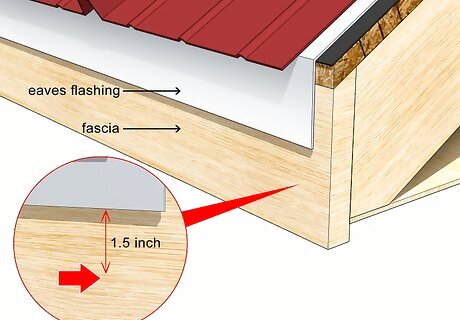
Mark the starting point of the gutter run 1.25 inches (3.2 cm) below the eaves flashing. The eaves flashing are the sheet metal pieces at the edge of the roof that protect the exterior of the building. Be sure to mark the starting point 1.25 inches (3.2 cm) below the flashing on the fascia —the straight, long board that runs along the lower edge of the roof. If your roof is longer than 40 feet (12.2 m), mark the chalk line in the center of the fascia. Since the gutter extends downward from the center to the left and right, this marks the start. If your roof is shorter than 40 feet (12.2 m), mark the starting point at the left or right of the roof.
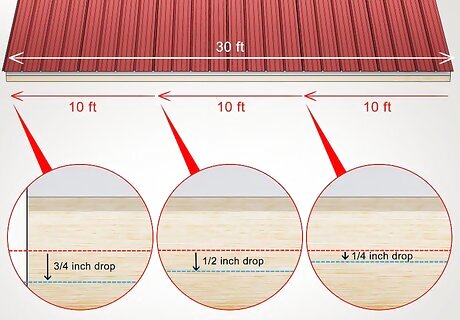
Determine the end-point of the gutter run using a ⁄2 inch (1.3 cm) downward slope. Locate the chalk line that marks the highest point of the gutter run. From here, mark a line in chalk on the fascia every 10 feet (3.0 m), moving down ⁄2 inch (1.3 cm) for every point. For example, if your gutter is 30 feet (9.1 m) long, it's going to run from one end of the roof to the other. This means you will mark 3 chalk lines along the fascia, with the final one marking the end-point of the gutter run. The first line will be ⁄4 inch (0.64 cm) down from the highest point, the second ⁄2 inch (1.3 cm) down, and the end-point ⁄4 inch (1.9 cm) down. Install gutters 1–1 ⁄2 in (2.5–3.8 cm) past the end point so they catch water from overhanging shingles.
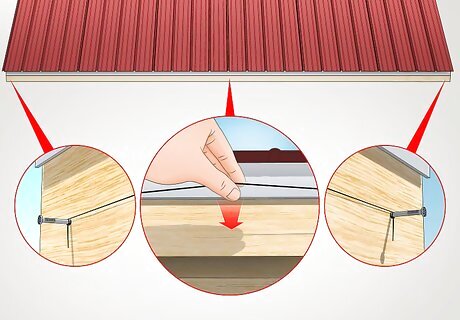
Snap a chalk line between the start and end of the gutter run. Locate the endpoints and hold a nail over each. Firmly hit the top of the nails with a hammer to drive them into each point. Hook one side of the chalk line to the nail at the start of the gutter run. Drag the string to the end point and hook it over the nail. After attaching the chalk line, pull straight up from the middle and let the string snap. Use blue and white chalk lines—red can bleed through the paint onto your fascia
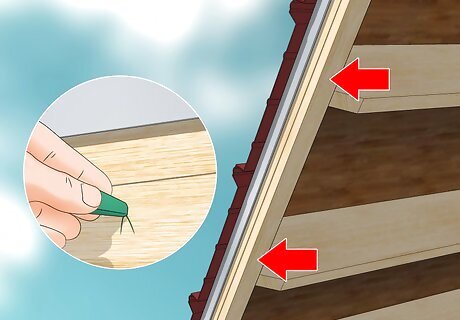
Mark the location of each rafter tail at the chalk line. Rafter tails are usually spaced apart 16 inches (41 cm) on center and can be located by their nail heads. Place a clear chalk mark at each point using a piece of chalk. Use a different color than the chalk line to help you distinguish them.
Attaching the Downspout Outlet and Caps
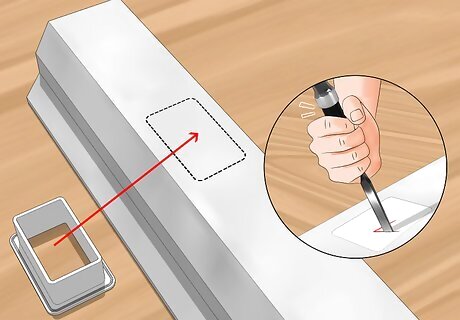
Mark the location of the downspout outlet. Measure from the corner of your home to the center of the downspout location. Now, transfer this measurement to the gutter and mark the center of the outlet on the bottom side of the gutter using a marker. Use a chisel and hammer to create a V-shaped start hole. Angle the chisel 45-degrees from the gutter and firmly hit the end with a hammer. Place the gutter face down on 2 scraps of wood for support while you chisel the starter hole. Use a gutter piece with a pre-installed outlet to skip this step.
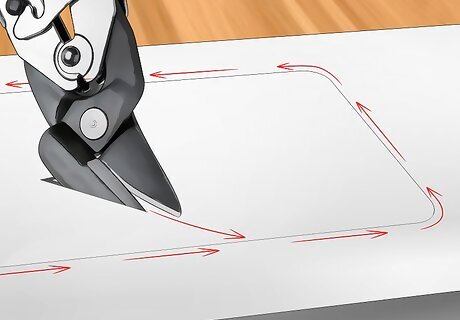
Remove the outlet hole using offset tin snips. Choose green snips if you're cutting clockwise and red tin snips if you're cutting counterclockwise. Be sure to cut ⁄16 inch (0.16 cm) outside of the outlet line. You can cut clockwise or counterclockwise—whichever you are most comfortable with.
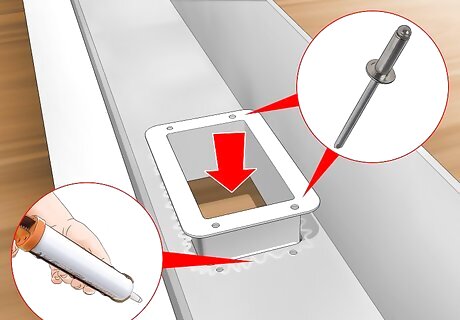
Attach the outlet into the hole and waterproof it with silicone glue. Place the outlet into the hole. Use an electric drill to create 2 ⁄8 inch (0.32 cm) holes for the rivets. Now, remove the outlet and apply a bead of silicone gutter sealant around the perimeter of the opening. Immediately insert the outlet into the opening and fasten the rivets through the holes. Use rivets with a ⁄8 inch (0.32 cm) diameter.
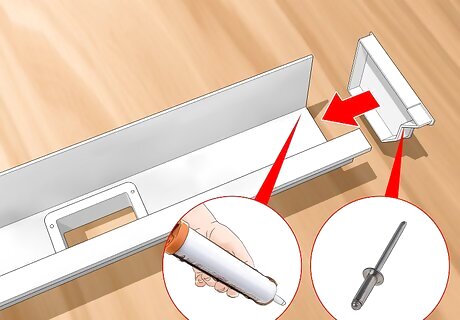
Connect the end cap(s) to the gutter using silicone sealant and screws. Hold the cap in place and insert a single sheet-metal screw into its hole. While this temporarily holds the cap in place, drill another ⁄8 inch (0.32 cm) diameter hole and attach a pop rivet into it. Now, remove the temporary screw and attach a rivet into the same location. After connecting the cap with rivets, apply a bead of silicone glue along the seam to waterproof it. Use a putty knife to smooth the silicone and press it into the joint.
Mounting the Gutters
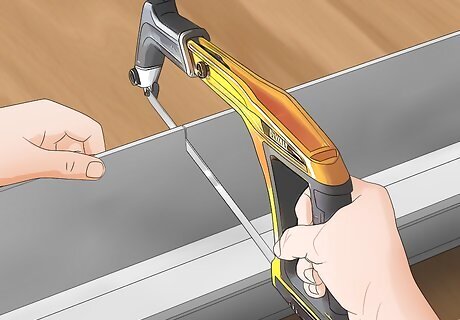
Cut the gutters to size with a hacksaw and heavy-duty tin snips. Mark the point to be cut on the gutters with an erasable marker. Hold the handle with your dominant hand and keep your index finger parallel to the top, pointing toward the cutting direction for support. Use the other hand to hold the frame at the top by the wingnut. Move the saw back and forth, using your dominant hand to move forward and backward and your non-dominant hand to apply downward pressure. Always cut your gutter on a flat surface. Use heavy-duty wire snips for smaller cuts. For gutters that run around corners, cut the appropriate angle—usually 45 degrees—at the applicable end.
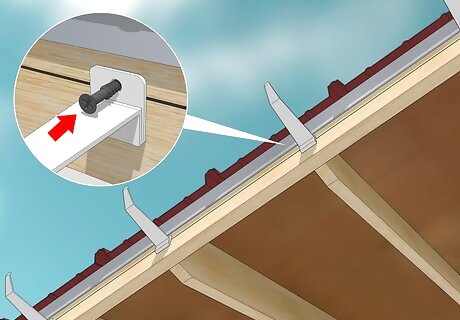
Attach the gutter's fascia brackets to the rafter tails. Drill a ⁄8 inch (0.32 cm) pilot hole through the fascia and into the rafter tails at each chalk mark. Afterward, attach the fascia brackets to using ⁄4 inch (0.64 cm) stainless steel lag screws at least 2 inches (5.1 cm) long. Apply soap to the lag screws to make it easier for them to penetrate the fascia. Review the manufacturer's recommendations for your type of gutter. Many gutter hangers come with long screws to go through your gutters and into the wood. To screw through the metal, turn them slowly at first so they can catch.
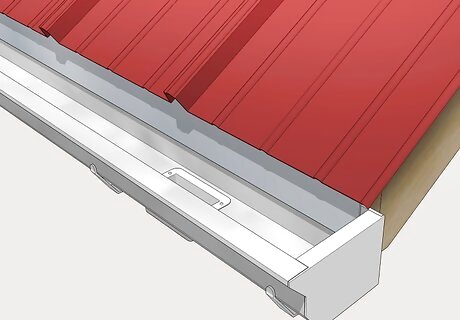
Mount the gutters to the fascia brackets. Lay your gutter into the fascia brackets that you attached to the rafter tails. Rotate your gutter upward (pushing it away from you) until the edge closest to the fascia fastens into the hook on the back of the bracket. If you're having trouble mounting the gutters, remove them and then place them on again, making sure that the edge closest to the fascia is underneath the fascia bracket hook before you rotate it.
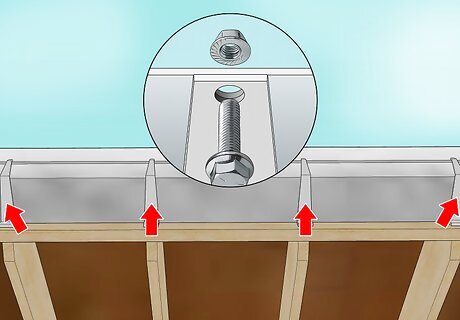
Secure the gutters to the fascia brackets using machine screws. Use an electric drill to create a ⁄16 inch (0.48 cm) diameter hole into the front side of the gutter. Afterward, insert a 1 inch (2.5 cm) #8-32 stainless steel machine screw through the hole and cap it with a flanged nut to secure the gutter to the bracket. Spray paint your brackets and gutters to contrast or match the house color.
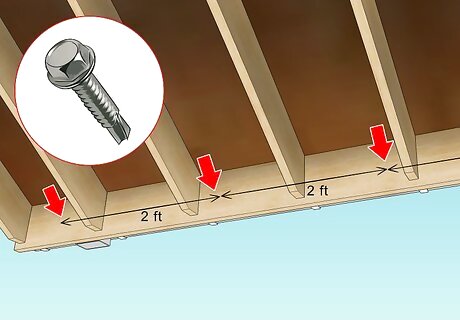
Attach the gutters to the fascia. Use an electric drill to drive 1 ⁄4 inch (1.9 cm) stainless steel hex head sheet metal screws through the back side of the gutter into the fascia. Be sure to do this once along every 2 foot (0.61 m) length along the gutter. After drilling in each screw, be sure to double-check the alignment of your gutter and ensure that it follows the chalk line. Take 100% silicone that is rated for exterior. Silicone the gap between the fascia board and the gutter. This will ensure that the water will run into the gutter and not behind it.
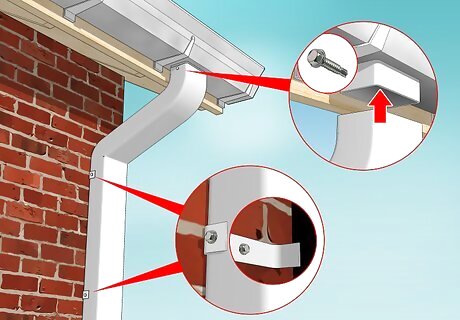
Attach the downspout to the gutters via the downspout outlet. Screw the downspout into the gutter outlet that extends downward from the gutter. Be sure that the tapered end of the downspout is facing the appropriate direction for drainage. Afterward, apply a heavy bead of sealant to the connection seams between the downspout and its connector and let them sit overnight to dry. Avoid aiming the tapered end toward regions with hose bibs, sidewalks, and electric meters. Join a 3–4 in (7.6–10.2 cm) PVC pipe to your downspout to divert rainwater into the ground if you want to get it further away from your home.


















Comments
0 comment